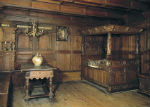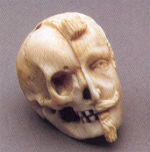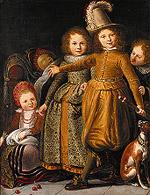



Renaissance
The word renaissance in its original Italian form means ”rebirth” and is the term for the period in which interest in classical Greek and Roman antiquity awoke again after the Middle Ages. Such terms, however, can be misleading. The antique culture was not forgotten in the medieval period and the Renaissance itself was to a large extent a product of the Middle Ages. In the National Museum’s exhibition the term is used broadly for the period from the Reformation in 1536 until the introduction of the absolute monarchy in 1660. In art historical terms this period spans the renaissance and auricular styles.
THE REFORMATION
The Reformation meant that the Danish Church became Protestant, with the king as its supreme protector, who also had the responsibility of choosing Denmark’s seven bishops. However, there was no violent destruction of altars, figures and paintings, but rather a gradual removal of the numerous images of saints and side altars from the Catholic period. The main elements in the new church organisation were that Danish became the language for church services instead of Latin, including for sermons and hymns, the giving of both wine and bread at the Eucharist and that there was finally a church discipline that made sure all knew their Christianity from an early age.
THE CROWN
The Crown benefited from the Reformation, in which the extensive lands owned by the Church were confiscated. The two greatest kings of the Danish Renaissance were Frederik II (1559-1588) and his son Christian IV (1588-1648). As genuine Renaissance princes, the kings displayed magnificent and costly lifestyles, as well as interest in foreign knowledge, art and culture, which cast a glorious lustre over their kingdom. At the same time they functioned as protectors of the Protestant doctrine both at home and abroad.
NOBILITY
The 1500s and the first decades of the 1600s were a heyday for the rich noble families, who surrounded themselves with splendour in the form of richly-furnished manor houses and costly personal possessions such as jewellery, weapons and drinking vessels.
SOCIAL STRATA
The town’s merchants formed a wealthy new upper class. They were involved in the government of the towns, for instance, serving as mayors. At the other end of the social scale were the sick and excluded, who supported themselves by begging. There were thus great contrasts within society.
KNOWLEDGE
Exploration meant that the world became larger during the period and fascination with the exotic resulted in the establishment of private collections of costly, rare and unusual objects. Technology, for example in the form of clocks and scientific instruments, interested many.
The king himself had a collection of rare and unusual objects, and much later this was to form the basis of the Old Nordic Museum, now known as the National Museum.
POLITICS AND WAR
The most important political objective of the Danish kings was to make sure that Denmark was the dominant power in the Baltic area, especially over the arch-enemy of Sweden. But they were unsuccessful in achieving this.
The background to the introduction of the absolute monarchy in 1660 was a war, in which Sweden had conquered all of Denmark, with the exception of Copenhagen, which withstood a Swedish assault in February 1659.
Numerous buried silver hoards testify to the Danish population’s attempts to hide way valuable possessions from the plundering enemy armies that ravaged the country.
More Renaissance?
Visit the exhibition on the Danish Middle Ages and Renaissance at the Natiional Museum in Copenhagen.